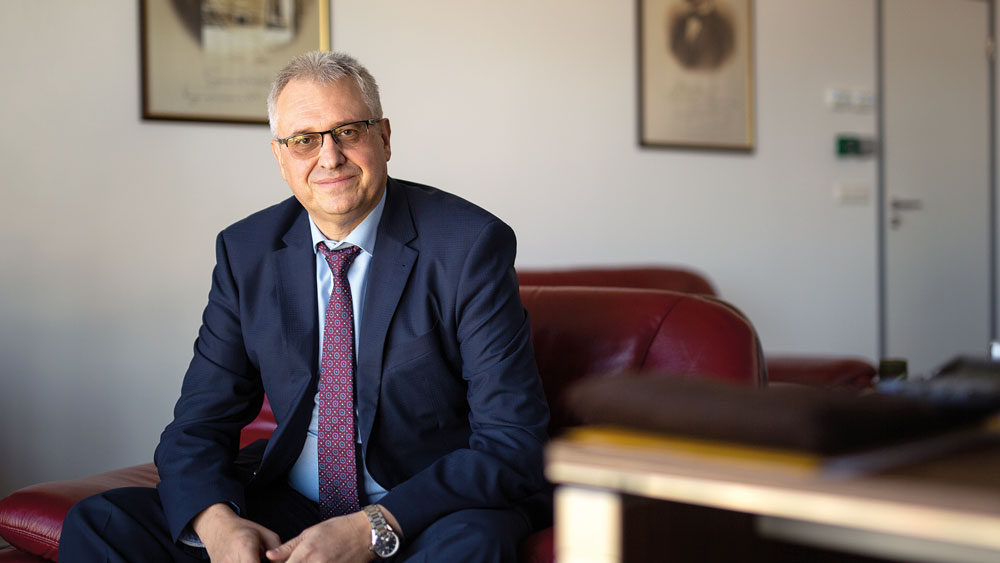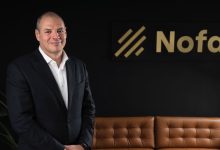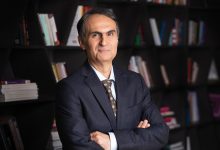Cristian Secosan: Setting the course – digitalization, automation and electrification
At the end of last year, Cristian Secosan took over the position of CEO, Siemens Romania and Moldova. Currently, Siemens Romania means a company with four factories, four research-development centres and over 2,200 employees, and has become over the years one of the leading providers of cutting-edge technology solutions. Cristian Secosan says about opportunities provided by the Romanian business environment in the activities covered by Siemens Romania that they have attracted investors’ interest and there are still prospects for growth.
Dear Mr. Secosan, you have recently taken over the management of Siemens Romania. What will be the priorities of the company this year?
Cristian Secosan: The strategic directions of Siemens, at global level, are digitalization, automation and electrification. These three areas of development reflect the entire portfolio of Siemens, as well as the major current trends.
Locally, I see development potential in all our areas of activity, especially as a result of the increasing interest of companies in digitalization, as well as in the context of dynamics in the recent years of investments in the railway and energy infrastructure.
Despite the often-legislative changes, do you believe Romania is still an attractive market?
Cristian Secosan: A predictable fiscal and political framework is definitely vital for investors. If we refer strictly to legislative changes, the essential factors for keeping stability and attractiveness of a market are decisional transparency and a real public consultation.
But investors’ interest is the result of a complex equation and Romania definitely has some aces up its sleeve, one of them being undoubtedly the quality of the workforce. The IT sector has attracted and continues to attract players around the world and Romania is already a true pole of research and development in the region. Production in the automotive industry is another field that has had a constant dynamics in the recent years.
From a strictly statistical point of view, according to the National Bank of Romania data, foreign direct investments increased slightly in 2018 compared to 2017 and the positive evolution was maintained in January 2019.
You have in Romania several factories and development centres. Do you plan to open a new production unit in a near future?
Cristian Secosan: Siemens operates in Romania four factories, three in Sibiu and one in Buzias, and four research-development centres, in Brasov, Cluj-Napoca and Bucharest. We do not consider opening new units in the near future, but the existing ones will be continuously developed.
The factories operated locally by Siemens have been substantially expanded, two-three years ago. Thus, the area of one of the factories in Sibiu was doubled and in Buzias a third production hall was inaugurated, which increased the area by around 60%.
As regards the research and development centres, the activity has been extended in the field of cyber security, with a dedicated team formed last year in Bucharest. Equally, the teams in Brasov and Cluj-Napoca have been strengthened with new specialists.
How many employees does Siemens currently have in Romania? Do you estimate an increase in their number in the following period?
Cristian Secosan: Siemens has in Romania over 2,200 employees. We constantly develop our teams, but it is an organic growth, based on the current business needs and not on opening new places of business.
In my opinions, success of an employer is measured in the level of satisfaction of employees and the retention of employees rather than in the increase in the number of employees. The fact that we have at Siemens a reduced fluctuation rate, of only a few percent, and quite a few colleagues who have already celebrated 10 and even over 15 years at Siemens, are an important indicator of the fact that we are a real team.
Was last year a good one for Siemens’ business in Romania?
Cristian Secosan: Siemens Romania recorded a positive evolution in the fiscal year 2018 (1.10.2017-30.09.2018), in line with the targets established. We have completed important projects in all areas of activity, from industrial automation and upgrade of power stations to technologies for buildings.
Moreover, 2018 also marked the winning of an important contract in the Republic of Moldova. The state-owned company Moldelectrica has selected Siemens Romania for the rehabilitation of 14 substations.
What are the projects you completed and/or started last year?
Cristian Secosan: Several important projects were completed last year to which we have also contributed, including: the construction and commissioning of the 110/20 kV substation for the Craiova East Industrial Area, upgrading works at the 400/220/110/20 kV Suceava Substation and the first renewable energy storage project on the domestic market.
The energy system remains a sensitive subject for Romania. We have an outdated base, whether we are talking about production or distribution. What caused this situation?
Cristian Secosan: Indeed, the energy infrastructure requires substantial investment, but it does not mean that upgrading does not take place. Modernization of the energy infrastructure is a long-term process and involves a long-term strategy. We will not have a fully modernized infrastructure within two-three years, but we have to take steps in the right direction.
If we refer to projects in which we have been involved, two power stations were inaugurated last year, of which one completely new. Moreover, if I look back, in Romania there are around 100 power stations modernized with Siemens equipment, both in the electricity transmission sector and in the distribution sector.
Also, there are more and more projects in the field of electricity generation, an important investment being already in the implementation phase. In the same field, another important element is that the technologies used to generate renewable energy have already reached the point where they can be self-sustained, without support schemes. This could generate the second wave of investments in the near future.
Over the years, Romania has had several energy strategies. They were all abandoned along the way. How do you explain this situation?
Cristian Secosan: A strategy involves assuming it and determination and cannot survive in absence of these two factors. I believe the political element has too often left its mark, which has led to lack of responsibility for the various strategies developed over time. However, there have been some elements of continuity in all the strategies developed, related especially to the major investments and the development of transmission networks.
There are several major investment projects that were included in all the energy strategies, but continue to be only on paper. Why we don’t manage to attract foreign investors to complete them? What are we missing, in your opinion?
Cristian Secosan: The lack of legislative and regulatory predictability is an important factor and here we have, unfortunately, some very recent examples. Also, the lack of decisions and the reduced capacity to manage major and complex projects at the level of the major players in the industry make very difficult even the implementation of the few existing projects.
In the last draft of the energy strategy investments in the energy system are estimated at tens of billions of euros. Public-private partnership is the only solution to attract these funds. How can the major companies in the industry be convinced to invest in the Romanian energy system?
Cristian Secosan: Public-private partnership is a quite complicated construction and therefore is difficult to implement. In my opinion, this isn’t the solution of financing the major strategic projects.
The worst situation is recorded in the heating system, where we have major problems and I refer especially to the large power plants owned by Oltenia Energy Complex and Hunedoara Energy Complex. Will they manage to comply with the new environmental regulations after 2020?
Cristian Secosan: Significant investments are needed for compliance and they have to be seen in the context of sustainability of these groups in the future. Also, CO2 emissions and the related mechanisms represent a real threat (in view of huge costs they generate), as well as an opportunity (due to financing possibilities they offer).
Large-scale renewable energy storage would create a major advantage for this type of energy. Does Siemens have storage solutions developed?
Cristian Secosan: Storage of energy from renewable sources is definitely vital for ensuring a constant energy flow in the network. Siemens has in its portfolio a smart renewable energy storage solution – Siestorage, which has already been implemented in Romania.
Black Sea gas fields are a major asset of Romania. For now, we are creating the impression that we don’t really know what to do with them and authorities are not very communicative with regard to this subject. How do you see the capitalization on this asset by Romania?
Cristian Secosan: Black Sea gas fields are a great opportunity for Romania, but to attract investors we must clearly establish the rules of the game. As I said before, predictability is vital for investors and this applies in any field. Currently, there are still many questions as to the framework in which the exploitation projects will be carried out and answers must be given to these questions.
The Smart City concept has gained ground in the recent years and Siemens has solutions developed in this field. In which cities of Romania have you applied them so far?
Cristian Secosan: Indeed, municipalities in Romania have embraced this concept and all the major cities have launched pilot projects. But this is only the beginning; the following step is integration of the various components (energy, mobility, health etc.) and this must be achieved based on a strategy allowing the flexible and staged implementation of the various technologies. Thus, a smart city can truly be created, a city providing high quality of life for its inhabitants.
Siemens has a portfolio covering all the key areas of a smart city: from e-mobility and smart power grids to smart management of traffic and buildings, with which we are also present in Romania. We have already implemented smart technologies in some cities, but we are talking about punctual projects, which aimed at smart traffic management, public transport, lighting, and not an integrated concept.
Also, Siemens teams in the research and development centres in Romania have been involved in extensive research projects in the field of Internet of Things, carried out at European level, the purpose being to create a framework allowing the development of Smart City-type applications. One of these projects is CityPulse. Siemens Corporate Technology team in Brasov has used this platform to build an application that locates buses in the city in real time and based on this data recommends the best routes for users.
Please give us some examples of solutions developed by Siemens.
Cristian Secosan: A reference project for Siemens expertise in the Smart City field is the Aspern neighbourhood, near Vienna, one of the largest Smart City projects in Europe. Aspern neighbourhood will have over 8,500 apartments and host over 20,000 jobs, by 2028. This integrated project includes e-mobility, smart power grids, smart lighting, infrastructure monitoring and energy management in buildings. At the same time, the project includes an important research component.
Do you have other projects of this type in progress? What are the solutions?
Cristian Secosan: Siemens develops and implements at global level a wide range of smart solutions. One of the recent research projects, tested in one of the busiest intersections in India, aims at using artificial intelligence in traffic management systems. Another research project aims at using electric cars as batteries for electricity supply to buildings, by integration in the smart management system of the building, and examples can continue.
What are the cities in Romania that fit best in the Smart City concept?
Cristian Secosan: Each project is important, providing various benefits, depending on the technologies implemented and the priorities of each city, therefore a classification is not relevant. For example, the time spent in traffic can decrease if you use smart traffic management systems, energy consumption can be reduced through a street lighting based on sensors, pollution can decrease by reducing the time spent in the car as a result of using parking applications and electromobility and the list can continue.







